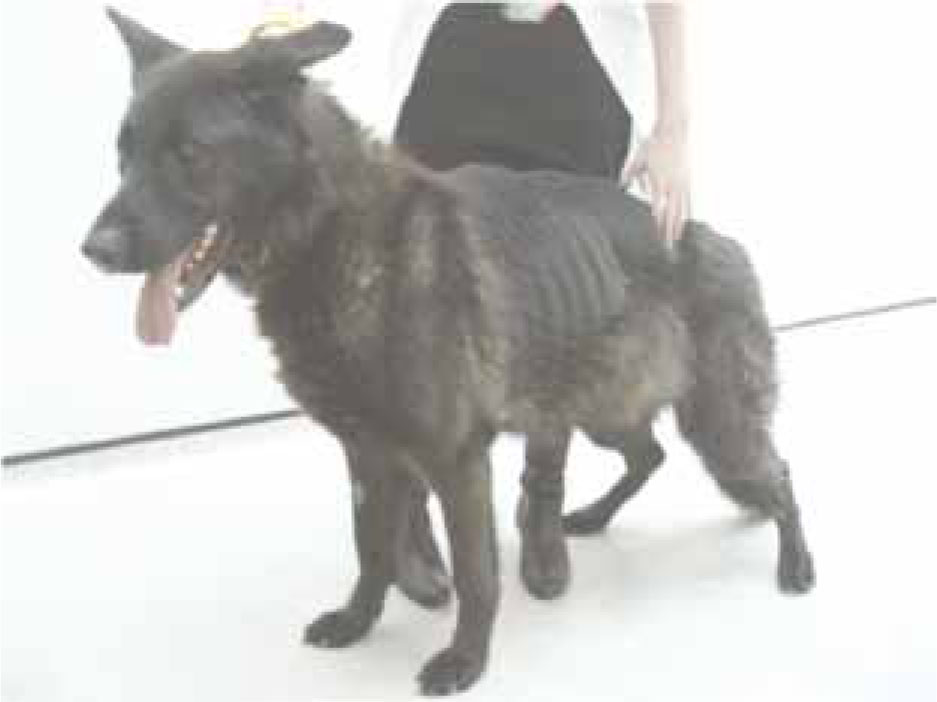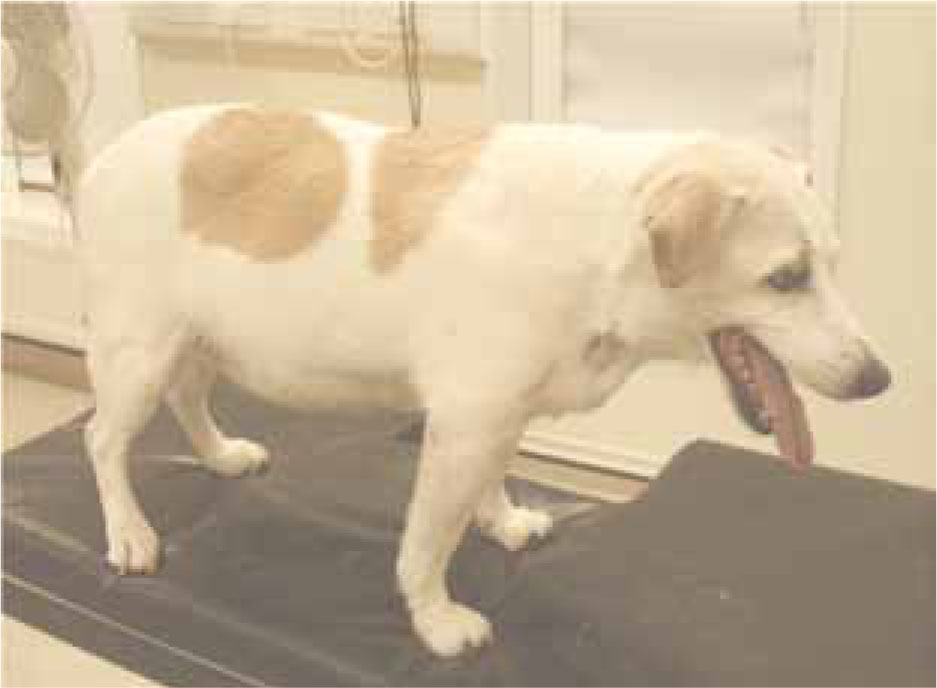Heart disease is one of the most common conditions in the dog. It is a broad subject, ranging from congenital disorders to acquired diseases, with some patients having no clinical signs, while others have life-threatening heart failure. Often when a patient is in heart failure they become anorexic, which can be one of the causes of cardiac cachexia. Anorexia has been shown to be a contributing factor for owners when considering euthanasia of their pet (Mallery et al, 1999). Concurrent diseases, heart failure medication, laboratory parameters and diet preferences of the patient and owner make it impossible to recommend a ‘best cardiac diet’ for all canine patients.
Heart disease
Heart disease can occur at any age. Common congenital defects in dogs include patent ductus arteriosus, aortic stenosis and pulmonic stenosis. The most common acquired canine heart diseases are degenerative mitral valve disease (DMVD) and dilated cardiomy-opathy (DCM). DMVD is seen in up to 75% of dogs presenting with heart problems (Atkins et al, 2009).
Heart failure
Heart failure occurs if cardiac output is compromised. It is characterized by clinical signs of in-creased tissue water retention (backwards failure), and/or decreased tissue perfusion (forward failure), due to heart disease. By definition, any patient with heart failure has heart disease. However, patients with heart disease may or may not develop heart failure. Congestive heart failure (CHF) specifically refers to the presence of backward failure (Table 1). It occurs when cardiac output is compromised and arterial blood pressure falls. This initiates compensatory mechanisms, which attempt to return blood pressure to a more normal level. These mechanisms include increased fluid retention by the kidneys, vasocon-striction, and stimulation of the heart to increase heart rate and stroke volume. If mild compensation is sufficient to normalize arterial pressure without causing effusions (pulmonary oedema, pleural effu-sion and/or ascites), then affected patients will not have clinical signs, or only develop signs if they undergo excessive exertion or stress. If more compensation is required to normalize arterial blood pressure, then this can result in the development of effusions. The affected patient therefore develops CHF (Figure 1). If arterial pressure cannot be normalized despite maximal activation of compensatory mechanisms, then forward failure is present.

| Left-sided congestive heart failure (pulmonary congestion and oedema) | Right-sided congestive heart failure (systemic venous congestion) |
|---|---|
| Tachypnoea, respiratory distress, orthopnoea | Ascites |
| Cough | Hepatomegaly and jugular distension |
| Lethargy and exercise intolerance | Dyspnoea (pleural effusion) |
| Syncope due to arrhythmias or hypotension | Exercise intolerance and syncope |
Classifcation of heart disease
The treatment, management and nursing aims depend on the stage of heart disease present. The most useful classification system is a version of the 2001 American College of Cardiology/American Heart Association system used in humans that has been modified for use in dogs with chronic valvular disease (Atkins et al, 2009), but can be used on dogs with all types of heart disease. Recommendations for diet, exercise and medication vary depending on the degree of heart disease present. Classification of the differ-ent stages is as seen in Table 2.
| Classification | Disease stage |
|---|---|
| Stage A | Patients at high risk of developing heart disease, but no structural disorder of the heart. Patients in this category are small–medium sized breeds such as Cavalier King Charles Spaniels, Papillions, Poodles, Dachshunds, and Chihuahuas. One study showed that in these breeds, the prevalence of heart disease in dogs over 10 years old was > 90% (Egenvall et al, 2006). |
| Stage B | Patients with structural heart disease that have never developed signs of heart failure. This is further sub-divided:-Stage B1: Patients with no evidence of radiographic or echocardiographic remodelling as a result of heart disease. Stage B2: Patients that have evidence of radiographic or echocardiographic remodelling as a result of heart disease. |
| Stage C | Patients with past or current clinical signs of heart failure associated with structural heart disease. |
| Stage D | Patients with clinical signs of heart failure that are refractory to ‘standard therapy’. |
From Pace (2011)
Cardiac cachexia
The most useful definition of cardiac cachexia is perhaps one taken from an American consensus statement on human cachexia. It described it as ‘a complex metabolic syndrome associated with underlying illness and characterized by loss of muscle with or without loss of fat mass’ (Evans et al, 2008). Cardiac cachexia usually occurs after the onset of CHF (Figure 2). It is a loss of lean body mass caused by anorexia, increased energy requirements, and metabolic alterations. A major factor in this syndrome is the increased production of inflammatory cytokines, such as tumour necrosis factor (TNF) and interleukin-1 (IL-1). These cytokines are directly known to cause anorexia, increase energy requirements and increase catabolism of lean body mass. It is a subtle progressive muscle loss that can occur in any patient with CHF, including obese patients. In one study of dogs with DCM, over 50% of patients had some level of cachexia (Freeman et al, 1998). The development of cachexia can be monitored in nurse clinics or routine appointments. Key factors that nurses should be aware of are:

Due to the increased fluid retention associated with heart failure, the patient may lose muscle condition, but not necessarily lose weight (Figure 3). One possi-bility is that veterinary nurses use a muscle condition score test, alongside a body condition score test (Box 1) (Purina, 2012) and weight checks, to assess cardiac patients on routine appointments. It is possible that with early recognition, cachexia could be treated with diet modification or supplementation.
Cachexia score for nurses
| Score | Level of muscle loss |
| 0 | No muscle wasting |
| 1 | Mild |
| 2 | Moderate |
| 3 | Marked |
| 4 | Severe |
Taken from Freeman (2010: 691)

Diet
As with the wide variance of heart disease, patients’ dietary needs also vary greatly. In one report, 66% of dogs with cardiac disease had concurrent diseases, which might influence dietary selection (Freeman, 2010a).
In addition, anorexia is frequently associated with patients in CHF. In one study, anorexia was reported to occur in 84% of dogs with CHF (Mallery et al, 1999). In the same study, anorexia was a contributing factor in the decision to euthanize 68% of dogs with CHF. Another complication is that at end-stage heart failure, Stages C to D, patients might be suffer-ing from cardiac cachexia and/or electrolyte disturbances (for example, increased loss of potassium, sodium and chloride due to diuretic therapy), and so their needs will also differ.
Another problem when planning nutrition for the cardiac patient is that dietary recommendations vary. Freeman (2010a) advises mild salt restriction for patients with heart disease, but without heart failure (Stage B). She follows that with a recommendation that salt restriction is increased at the onset of CHF (Stage C). Luis Fuentes (2010), however, recommends that low salt diets should not be used before the onset of CHF, because low sodium can stimulate compensatory mechanisms to retain water, which would increase volume load on the heart. Another consideration is that low salt diets are often less palatable, which can be a problem in the anorexic patient. An-ecdotally, owners often try anything to get their pet to eat, and these alternatives are often high salt foods, such as cheese or processed meats. Another study showed that 62% of owners used human foods to give medication (Freeman et al, 2002).
One study assessed nutrient intake of dogs with cardiac disease, of which less than a third were in CHF (Freeman et al, 2003). Nutrients of concern were calorie content, protein, fat, sodium, potassium and magnesium. In the study, 20% of dogs were eating less protein than Association of American Feed Control Officials (AAFCO) guidelines (Freeman et al, 2003). Due to the loss of lean body mass seen with cardiac cachexia, an adequate amount of good quality protein should be maintained. Fat within the diet provides calories and increases palatability of food, although can have significant adverse effects on health when consumed in excess. It is possible that potassium levels may vary in dogs on CHF medication. Increased diuresis at Stages C to D, might lead to increased potassium loss in urine, therefore supplementation may be necessary. Alongside any dietary modification associated with CHF medication, blood parameters such as electrolytes and renal function should be routinely measured. As with potassium, magnesium levels may also vary depending on disease severity and treatment. Hypomagnesaemia has been reported in dogs with CHF, so magnesium levels should also be monitored regularly if patients are on cardiac medication (Cobb and Michell, 1992).
Any diet given to the dog with cardiac disease should be evaluated individually. Salt, protein, and fat content can vary from one diet to another. In addition, some diets have supplements added to them such as L-carnitine, antioxidants, vitamins and ome-ga-3 fatty acids. There are currently only two specific veterinary diets available for the dog with cardiac disease, Royal Canin Veterinary Diet Cardiac and Hills Prescription H/D. As already stated, use of these particular diets should be assessed in conjunction with the patient's heart disease stage and the patient's individual needs. Furthermore, it is important to remember that any change in diet should be introduced slowly to reduce the possibility of gastrointestinal problems. It is also recommended to only change a diet when the patient is stable clinically, and at home (Freeman, 2010b). Any attempt to do so if the patient is suffering from acute heart failure, or in the hospital may lead to a food aversion. Unlimited access to water should be provided for all patients.
Obesity
Obesity is associated with increased heart rate, blood pressure and exercise intolerance. Maintaining an optimum bodyweight and body condition score should be the ultimate aim in any patient, but specifically those breeds either at risk of heart disease (Stage A) (i.e. Cavalier King Charles Spaniels and terrier breeds), or those with disease in stage B. However, several studies have shown that in people with heart failure, obesity is actually associated with a longer survival time (Davos, 2000; Horwich et al, 2001; Mosterd et al, 2001), which is known as the ‘obesity paradox’. Results of one study which looked at the relationship between bodyweight, body condition and survival in dogs with heart failure, showed that the dogs who gained or maintained weight had a longer survival than those that lost weight (Slupe et al, 2008). Therefore patients with heart failure, even those that are overweight or obese, should be monitored for unintentional weight loss. Nutritional management should endeavour to provide the individual with the optimum number of calories required, to avoid deficiencies and excesses and gain potential pharmacological effects of certain nutrients contained within the diet.
Exercise
There have been no studies looking at the role of exercise in the canine cardiac patient, but quality of life and owner expectation play a part in the decision to exercise. The general recommendation is to exercise normally when heart disease is stable, or has been stabilized medically, but to restrict all exercise completely when the patient is in CHF (Luis Fuentes, 2010).
Nutraceuticals
There is a growing interest by health professionals and the public in nutraceutical therapy for specific conditions. This may be due to dissatisfaction with conventional drug therapy, or because of the role that the media plays in attracting attention to them. When considering dietary supplementation, it is important to note that the industry is largely unregulated. One website that may provide information is consumer-lab.com, which publishes reviews of independently tested dietary supplements for humans, and some pet supplements. If owners wish to supplement their pet's diet, it is worth advising them that this is additional medication, that some of the supplements can be expensive, and that any supplementation should be overseen by a veterinary professional.
A variety of dietary supplements are used in veterinary cardiology, some of which are based on scientific knowledge, and some of which are not. The most commonly used in veterinary cardiology are:
| Nutrient | Notes |
|---|---|
| Omega-3 fatty acid | Shown to be effective in dogs with cardiac cachexia Anti-arrhythmic benefits |
| L-carnitine | Has been shown to improve cardiac function May be beneficial in some dogs with DCM |
| Taurine | Can improve systolic function of the heart (pumping ability) if taurine deficient |
| Coenzyme Q10 | Believed to be a potent antioxidant and cardioprotective Not proven in clinical veterinary patients |
| Protein | No restriction necessary |
| Fat | Increases calories and palatability of food Excess should be avoided |
| Sodium | Start sodium restriction on clinical signs of CHF |
| Potassium | Supplement if blood tests indicate hypokalemia |
| Magnesium | Supplement if blood tests indicate hypomagnesia |
| Vitamins | Those patients receiving diuretic treatment may have higher vitamin B requirements |
| Antioxidants | Now supplemented in many diets, but use in veterinary medicine yet to be proven |
Omega-3 fatty acids
Omega-3 fatty acids, namely eicosapentaenic acid (EPA), and docosahexaenoic acid (DHA) are found in fish oils. There have been proven benefits with the use of omega-3 fatty acids. They have been shown to decrease cytokine production and improve endothelial function in chronic inflammato-ry disease associated with CHF (Moertl et al, 2011). They have been shown to have a positive effect in dogs with cachexia (Freeman et al, 1998), due to their anti-inflammatory effect. They may also have an anti-arrhythmic benefit in ventricular arrhythmias in dogs (Smith et al, 2007). The recommended dose is 40 mg/kg EPA and 25 mg/kg DHA. These should only be taken under the supervision of a veterinary professional.
Taurine
Historically, a lack of taurine has been linked to DCM in cats, but it is thought that dogs can synthesize suf-ficient amounts of taurine. However, there does seem to be a link between certain breeds of dog and taurine deficiency. Those breeds affected are American Cocker Spaniels, Golden Retrievers and Newfoundlands. There is difference of opinion amongst cardiologists as to whether to recommend taurine supplementation for those breeds known to be at risk (Stage A), or to supplement if and when the patient reaches Stage B (Dukes-McEwan, 2010).
L-carnitine
L-carnitine deficiency has been associated with DCM. Improvements in cardiac function were reported after administration of a supplement (Keene, 1999). Recommendations are suggested for some American Cocker Spaniels (Freeman, 2010b). Other cardiologists suggest it could be considered in dogs with DCM (Keene et al, 1991; Kittleson et al, 1997). Luis Fuentes (2010) suggests that supplementation may be useful in some familial cases of L-carnitine deficiency but in most cases, the effect of supplementation is minimal.
Coenzyme Q10
The role of coenzyme Q10 in veterinary cardiology is yet to be defined. It is believed to be a potent antioxi-dant, and is thought to be cardioprotective because it neutralizes free radicals produced in the myocardium of human heart failure patients. Clients should be advised of the high costs associated with this supplement, and the lack of supporting clinical data.
Disease management clinics
Supportive and palliative nursing of patients is a vital aspect of veterinary practice. Nurse clinics can provide information and support for owners, which can help maintain their dog's quality of life. Visits can be used to assess whether the patient is eating, and whether or not the owner is able to give medication. If the patient comes for a clinic appointment, body condition score, muscle condition score (see Box 1) and bodyweight can be monitored (Box 2). However, if a visit to the veterinary practice causes a patient to get stressed, then it should be avoided, because of the detrimental extra demand it places on the heart. In these cases, a telephone call is preferable.
Nursing checklist for the patient with heart disease
Practical nursing considerations of dietary management:
Practical tips for nurses if the patient is anorexic:
Conclusion
Medical and optimal diet therapies are the key for controlling a dog with heart disease and heart failure. As yet, there are no universal recommendations for levels of dietary sodium, chloride, potassium or magnesium for animals with heart failure. Therefore, designing a diet for these patients can be difficult when basing exact requirements on assumptions. It is best to match the nutritional needs of the individual to the diet that best suits their needs. Adjustments should be based on the degree of heart disease, bodyweight, laboratory parameters, food preferences and veterinary surgeon advice. Changes to the diet should be made only when the patient is medically stable. Further clinical studies into efficiency of dietary management are needed to optimize therapeutic strategies for the canine patient with cardiovascular disease.
